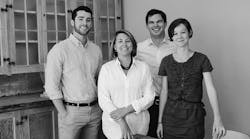Today, residents and business owners in downtown Fredericksburg strive to stay true to its historical roots as the site of a well-known, pivotal Civil War battle. At the same time, Spaces Design Studio, located in the heart of the area’s historic district, has been working as a team to revitalize the area alongside ambitious, successful local business owners and entrepreneurs.
Principal Stacey Lampman spent time living in Old Town in Alexandria, Va., so she had familiarity with historical areas when she decided to open Spaces in 2007. After working as project manager and senior designer at renowned firms such as the Ward Hale Design Group, Smithgroup, and HOK, she had a goal of delivering the same results as these large entities but with her own small team—a core group of four people (including herself). “We are trying to create,” she noted. “The point for establishing Spaces was to create a team of people but mimic larger firms. [Even though our team is small], we do large projects.”
Lampman recalled downtown Fredericksburg businesses being mostly antique shops when Spaces opened. Today the area is rich with restaurants, breweries, retail establishments, art spaces, professional firms, and even woodworking shops and yoga studios. While this development is exciting, and has certainly kept Lampman and her team busy as they have been involved in the construction and design of many of these businesses, Spaces has to remain cognizant of local building codes and ordinances, particularly when working with historical buildings.
The Architectural Review Board (ARB) is consistent nationwide; it is ultimately the overseer of any historic district. That’s usually the biggest challenge.” As the city’s website states, “[t]he purpose of the Architectural Review Board is to maintain the historic and architectural integrity of designated historic areas.”
One of the most daunting tasks when working in historical buildings, Lampman explained, is making sure they comply with modern codes. Buildings constructed in the 1800s often present challenges when it comes to the Americans with Disabilities Act (ADA) guidelines, fire codes, and plumbing. “In most old towns they’ve raised the street level so most buildings have steps; nothing is ever level. We need to modify doorways to make them meet the ADA code. Fire codes are the next biggest challenge since the materials that were used in the 1800s are combustible.
It’s hard to prove they have a fire rating. And we have a lot of situations where there is no second means of egress out of the building. Then with bathrooms and plumbing there is just limited space for an ADA bathroom. That being said, I think the city of Fredericksburg is very aware of what a difficult task this is so they try to be accommodating and they are reasonable. We work with the ARB.”
The citizens and business owners of Fredericksburg have a commitment to being “good stewards”—Lampman included. “And people who are moving here are doing their best to modernize old buildings without ruining them. Often they are coming here from areas like D.C. or Charlottesville or Richmond, so they are used to old town challenges. The downtown historic district [in Fredericksburg] has a built-in community that is 100-percent loyal and supportive. They won’t go to [the large shopping areas]; they invest in the businesses that are downtown. We’ve worked in so many different types of spaces and they all seem to do well because of that [community spirit].”
PageBreakIn keeping with the goal of being good stewards, Spaces is committed to salvaging materials from historical sites the team redesigns. This includes things like using old barn wood to make a conference table, preserving hand-sawn beams and columns, maintaining floor joists, and re-exposing original brick walls. “Sometimes you have to prove your case in a sense and reference the historic value of the building,” Lampman noted. “There are drastic differences between buildings constructed in the 1950s and 60s and the 1800s. There has only been one case in which we have been able to modify the exterior, which was Vivify [a popular burger spot with a rooftop bar]. For the most part, the modern portion comes on the interior, which doesn’t necessarily have an impact on the overall historic feel of the area.”
This ties into the sustainability story when working in a historical area, which for Spaces means not only reusing materials and maintaining existing structures but also offering an Interiors Library that comprises green products, which clients don’t necessarily realize. “In an effort to be good stewards we work to supply materials that don’t create a negative impact on the environment,” Lampman said.
Another challenge comes by way of access to product. While many design firms in more metropolitan areas are regularly called on by manufacturer reps with the latest offerings, Spaces was slighted in this respect until recently. “Product reps are first starting to come here,” Lampman said, “and we have easier access to new products instead of having to do extensive research. That’s one challenge for creative, along with introducing new products to contractors who need to be educated on them.”
The positive that has come from this roadblock, Spaces team member Kelly Penick noted, is the opportunity to work with local artists. Unique product and designs are custom made for a job and/or delivered sooner since they are produced in town. The lack of access to the latest options “encourages us to look at local versions of products. We use a local ceramic artist for tile and a local metal fabricator for furniture so there is less wait time. We also call on a local street artist for murals.”
The gumption to work through any and all challenges is afforded by the caliber of Spaces’ clients; according to Lampman, they are ambitious people who know what they want. With a strong entrepreneurial spirit, the business owners working with the firm have a desire to see their visions executed effectively. “We attract a certain kind of client. They are definitely more out-of-the-box and creative. And these people like our fun work environment. We help with what they desire and achieve what they want for their businesses, not what we want. Our clients have been to other cities and have seen modern takes on design or challenges to traditional interiors. People were craving [that here] but there was no local resource. We came in and challenged the norm of the colonial feel which is what people wanted.”


